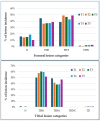Evaluating the Effectiveness of Probiotic and Multivalent Vaccination Strategies in Mitigating Bacterial Chondronecrosis with Osteomyelitis Lameness Using a Hybrid Challenge Model
- PMID: 40003050
- PMCID: PMC11851777
- DOI: 10.3390/ani15040570
Evaluating the Effectiveness of Probiotic and Multivalent Vaccination Strategies in Mitigating Bacterial Chondronecrosis with Osteomyelitis Lameness Using a Hybrid Challenge Model
Abstract
Bacterial chondronecrosis with osteomyelitis (BCO) is caused by several bacteria, including Salmonella, Staphylococcus spp., Escherichia coli, Enterococcus spp., and Mycoplasma spp., and BCO is a significant animal health and welfare issue in broiler production, causing 1-2% of bird condemnation at marketing age and resulting in annual losses of tens of millions of dollars. This study evaluated the efficacy of a probiotic program alone and combined with a multivalent electron beam (eBeam)-inactivated vaccine in reducing BCO lameness. The probiotic program included an Enterococcus faecium spray (E. faecium 669, at 2 × 109 CFU/bird) at hatch and a triple-strain Bacillus-based product (B. subtilis 597, B. subtilis 600, and B. amyloliquefaciens 516 at 1 × 109 CFU/bird/day) in drinking water from day 1 to day 56. An aerosol transmission challenge model simulated commercial bacterial exposure. Birds were divided into five groups: a positive control (PC) group (T1) and a negative control (NC) group (T2) receiving no treatment and three treatment groups receiving the probiotic program (T3), the multivalent vaccine (T4), or both the probiotic program and the multivalent vaccine (T5). Data analyzed via ANOVA (p < 0.05) showed T3, T4, and T5 had significantly lower lameness (43.7%, 40.3%, and 40.7%) than T2 (71.0%) and T1 (83.0%). T5 resulted in reductions comparable to T4, indicating no significant synergistic effect. These findings show that probiotics alone or with a vaccine effectively mitigate BCO lameness, enhance broiler welfare, and reduce economic losses.
Keywords: BCO; broilers; eBeam-inactivated vaccine; lameness; probiotic.
Conflict of interest statement
Reginald Onyeme and Sara Reichelt are employees of Aviagen North America. Antoine Meuter is an employee of Novonesis Group. The authors declare that this study received funding from Aviagen North America and Novonesis Group. Aviagen North America provided fertile eggs, and Novonesis Group supplied feed additives. The funders were not involved in the study design, data collection, analysis, interpretation, manuscript writing, or the decision to publish this manuscript. The remaining authors declare that the research was conducted in the absence of any commercial or financial relationships that could be construed as a potential conflict of interest.
Figures








References
-
- USDA Poultry Sector at a Glance United States Department of Agriculture. [(accessed on 2 June 2024)];2023 Available online: https://www.ers.usda.gov/topics/animal-products/poultry-eggs/sector-at-a...
-
- Tallentire C.W., Leinonen I., Kyriazakis I. Breeding for efficiency in the broiler chicken: A review. Agron. Sustain. Dev. 2016;36:66. doi: 10.1007/s13593-016-0398-2. - DOI
-
- Mandal R.K., Jiang T., Al-Rubaye A.A., Rhoads D.D., Wideman R.F., Zhao J., Pevzner I., Kwon Y.M. An investigation into blood microbiota and its potential association with Bacterial Chondronecrosis with Osteomyelitis (BCO) in Broilers. Sci. Rep. 2016;6:25882. doi: 10.1038/srep25882. - DOI - PMC - PubMed
Grants and funding
LinkOut - more resources
Full Text Sources
Miscellaneous

